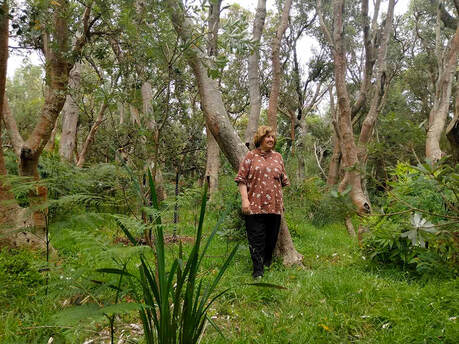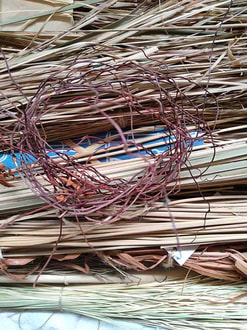 Mae Adams in her spectacular Venus Bay bush garden. Photos: Catherine Watson
Mae Adams in her spectacular Venus Bay bush garden. Photos: Catherine Watson By Catherine Watson
THERE’S no separation between Mae Adams’ life and art. Walking or weeding on her bush block, she’s surrounded by the lomandras, saw sedges and dianellas that go into her exquisite weavings. She wakes to the sight of her finished works on the walls and bunches of dried plants around her. It’s as if they have entered her dreaming.
Mae’s weavings are held in private collections in Australia and the US, as well as in the National Gallery of Australia, the Museum of Contemporary Art, in Santiago, Chile, the La Trobe Regional Gallery and the Gippsland Art Gallery.
THERE’S no separation between Mae Adams’ life and art. Walking or weeding on her bush block, she’s surrounded by the lomandras, saw sedges and dianellas that go into her exquisite weavings. She wakes to the sight of her finished works on the walls and bunches of dried plants around her. It’s as if they have entered her dreaming.
Mae’s weavings are held in private collections in Australia and the US, as well as in the National Gallery of Australia, the Museum of Contemporary Art, in Santiago, Chile, the La Trobe Regional Gallery and the Gippsland Art Gallery.
Unimaginable for a kid who grew up in a large family with limited means, in a regional area, and who left school at 16. Art was on no one’s radar. Her father was delighted when she got a job in an HBA office. After a couple of years Mae was bored out of her brain.
By then she’d saved up some money and she decided she would use it to return to study at the local TAFE college. She’s still not sure why she chose to study art. And suddenly the world opened up to her and she knew she had found her place in it. “The teachers were wonderful. We learnt about design, art history …”
By then she’d saved up some money and she decided she would use it to return to study at the local TAFE college. She’s still not sure why she chose to study art. And suddenly the world opened up to her and she knew she had found her place in it. “The teachers were wonderful. We learnt about design, art history …”
| After college, she managed a couple of years as a full-time painter before accepting that it was impossible to make a living. She returned to study for a Dip Ed and began teaching art at the Morwell Technical College. Of course it was taxing but then she went part time, which left her time for her own art. | Mae Adams’ works feature in the PICES 2024 In Focus Exhibition at Berninneit, the Cowes Cultural Centre, from January 31 - February 12. The three featured artists, including painter Mark Schaller and sculptor Andrew Kasper are in conversation with journalist Catherine Watson on Sunday, February 4, at 2pm. All welcome. |
One thing led to another. Over the years she taught at TAFE colleges and universities, did graphic design work for film studios, ran galleries, curated exhibitions and worked in arts administration.
Each block of work bought her time for her own work. It also enabled her to buy a bush block at Point Smythe, across the inlet from Inverloch. She put a caravan on it and returned there between contracts. Over the years, as she earned the money, she built her cottage.
She has been lucky – or brave – enough to spend her career in the arts world, though not in the way she initially contemplated.
And that’s a point that she wants to get across to young people in regional areas who are interested in the arts.
“When they tell young people they can’t make a career in the arts, it’s simply not true. There are all these opportunities you never realise.”
Each block of work bought her time for her own work. It also enabled her to buy a bush block at Point Smythe, across the inlet from Inverloch. She put a caravan on it and returned there between contracts. Over the years, as she earned the money, she built her cottage.
She has been lucky – or brave – enough to spend her career in the arts world, though not in the way she initially contemplated.
And that’s a point that she wants to get across to young people in regional areas who are interested in the arts.
“When they tell young people they can’t make a career in the arts, it’s simply not true. There are all these opportunities you never realise.”

When she returned to live full time at Point Smythe in 2008, she envisaged returning to painting, only to find the muse had deserted her.
One day she attended a talk at Wilsons Prom by an indigenous weaver. When she got home she looked at the plants around with a new interest.
And she began weaving. Once again, she had found her place. She loves the slow emergence, the reimagining of natural materials, which allies with her growing interest in bush land conservation and sustainability.
She likes that the works have a utilitarian aspect to them as well as their aesthetic appeal. “The process of gathering, preparing materials and slow stitching is meditative and satisfying; it’s both creative and ancient.”
One day she attended a talk at Wilsons Prom by an indigenous weaver. When she got home she looked at the plants around with a new interest.
And she began weaving. Once again, she had found her place. She loves the slow emergence, the reimagining of natural materials, which allies with her growing interest in bush land conservation and sustainability.
She likes that the works have a utilitarian aspect to them as well as their aesthetic appeal. “The process of gathering, preparing materials and slow stitching is meditative and satisfying; it’s both creative and ancient.”
